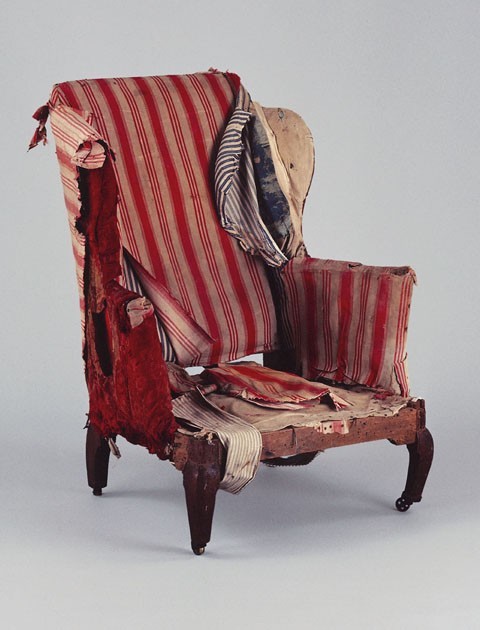
Easy chair, England or eastern Virginia, ca. 1745. Walnut with beech; original upholstery with later additions. H. 45 3/4", W. 30 1/4", D. 30 1/2". (Courtesy, Colonial Williamsburg Foundation; photo, Hans Lorenz.)
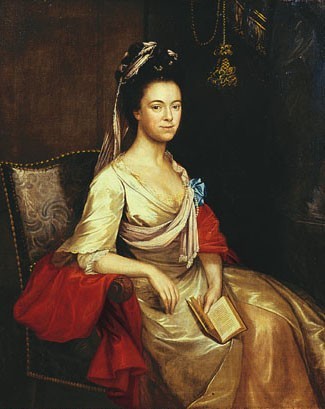
Matthew Pratt, Mary Jemima Balfour, Hampton,Virginia, 1773. Oil on canvas. 49" x 39 1/2". (Courtesy, Virginia Historical Society.)

Illustration of a standard eighteenth-century approach to over-the-rail upholstery: (a) front seat rail, (b) straw or grass roll, (c) linen casing for roll, (d) top linen, (e) show textile, (f) removable shoe molding, (g) rear seat rail, (h) horse hair stuffing, (i) foundation linen, (j) webbing strips. (Drawing, Leroy Graves; artwork, Wynne Patterson.)
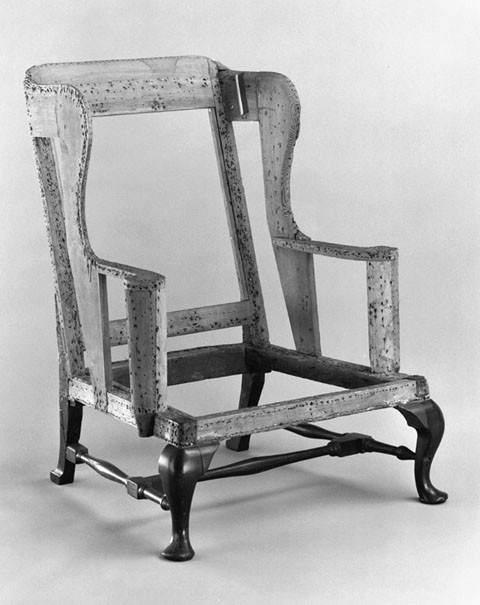
Easy chair attributed to the Anthony Hay shop, Williamsburg, Virginia, 1750–1770. Mahogany with ash, tulip poplar, and yellow pine. H. 44 1/8", D. 28 1/2", W. 31 3/4". (Courtesy, Colonial Williamsburg Foundation; photo, Hans Lorenz.)
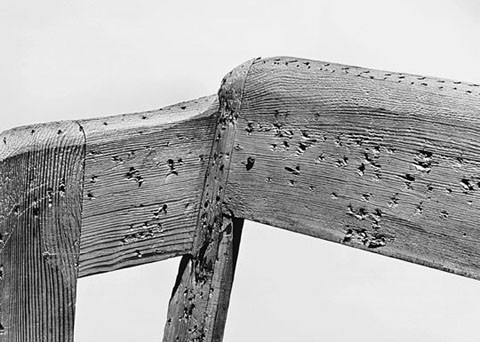
Detail of a rasp-shaped wing on the easy chair illustrated in fig. 4, showing clusters of nail holes related to the original webbing on the lower edge of the back and wing.

Side chair, Fredericksburg, Virginia, ca. 1815. Mahogany with ash and yellow pine.
H. 36 1/2", W. 21 1/4", D. 18". (Courtesy, Colonial Williamsburg Foundation; photo, Hans Lorenz.)
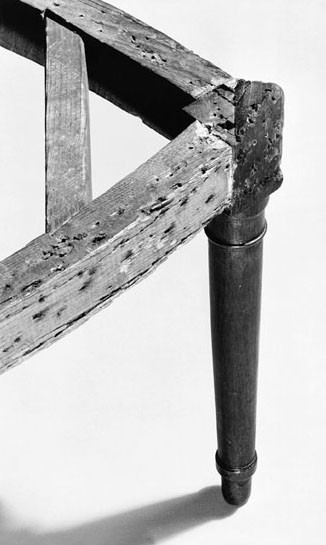
Detail of an upholstery peak on the side chair illustrated in fig. 6. (Photo, L. Graves and F. C. Howlett.)
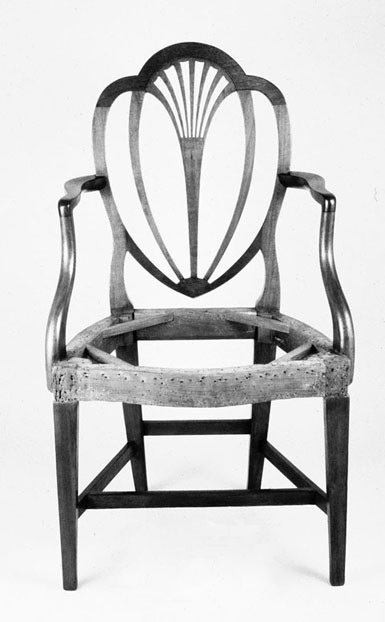
Armchair, probably Norfolk, Virginia, ca. 1790. Mahogany with ash. H. 38 3/4", W. 20 3/4", D. 17 3/4". (Courtesy, Colonial Williamsburg Foundation; photo, Hans Lorenz.)
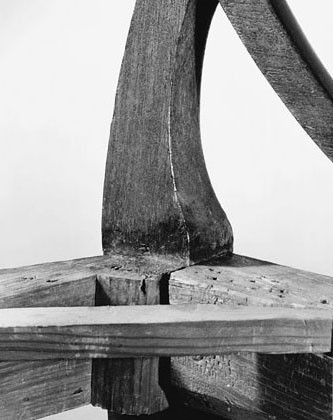
Detail of shadow marks indicating early or original upholstery profiles on the chair illustrated in fig. 8.
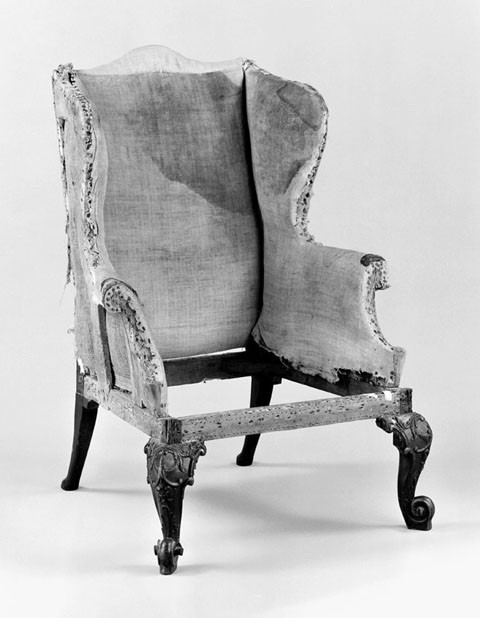
Easy chair, England, 1750–1760. Mahogany with beech and deal; remnants of original upholstery. H. 47", W. 32 3/4", D. 25 1/2". (Courtesy, Colonial Williamsburg Foundation; photo, Hans Lorenz.)

Detail of an original edge roll on the wing of the easy chair illustrated in fig. 10.

Armchair attributed to Edmund Dickinson, Williamsburg, Virginia, ca. 1775. Cherry; oak slipseat. H. 38 1/4", W. 26 1/2", D. 18 1/2". (Courtesy, Colonial Williamsburg Foundation; photo, Hans Lorenz.)
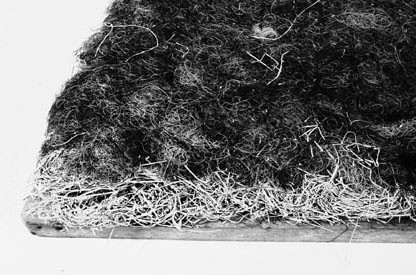
Detail of the slipseat from the armchair illustrated in fig. 12. (Photo, F. C. Howlett.) The seat has its original curled hair and grass stuffing.
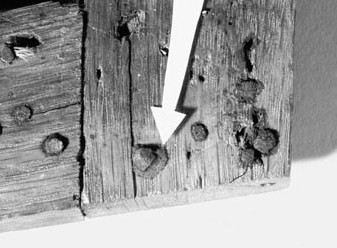
Detail of a leather fragment trapped beneath a forged nail on the seat frame of the chair illustrated in fig. 12. (Photo, L. Graves.)
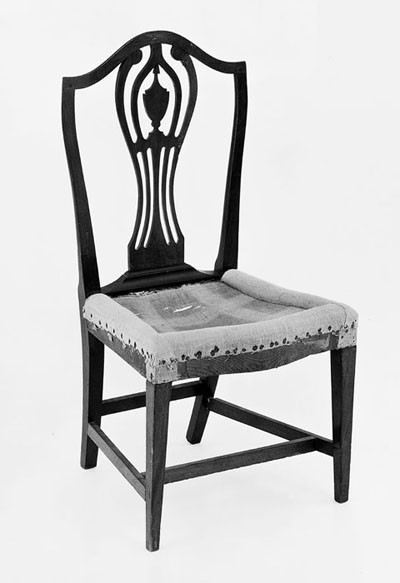
Side chair, New England, 1790–1800. Mahogany with cherry and yellow pine; original upholstery foundation with remnants of haircloth cover. H. 40 3/8", W. 20 3/4", D. 18 1/4". (Private collection; photo, Hans Lorenz.)

Detail of textile imprints on the seat rail of the chair illustrated in fig. 15.
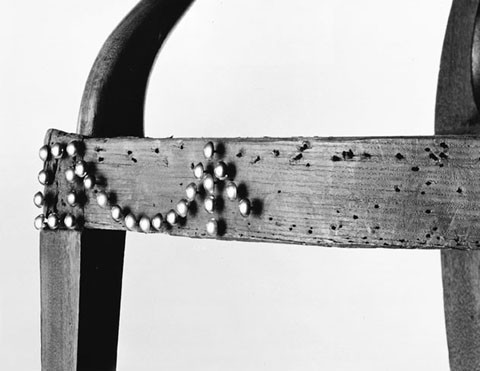
Detail of modern brass nails used to point out the original nail pattern on the chair illustrated in fig. 8.
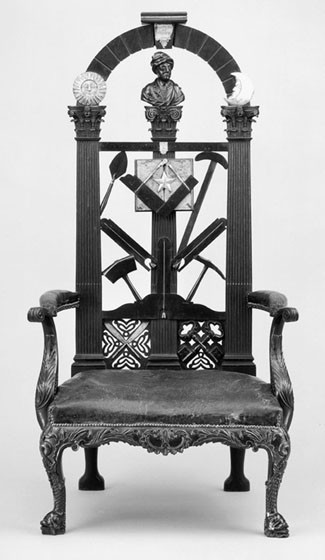
Masonic master’s chair signed by Benjamin Bucktrout, Williamsburg, Virginia, 1769–1775. Mahogany with walnut; original black-grained leather upholstery with brass nail trim. H. 65 1/2", W. 31 1/4", D. 29 1/2". (Courtesy, Colonial Williamsburg Foundation; photo, Hans Lorenz.)
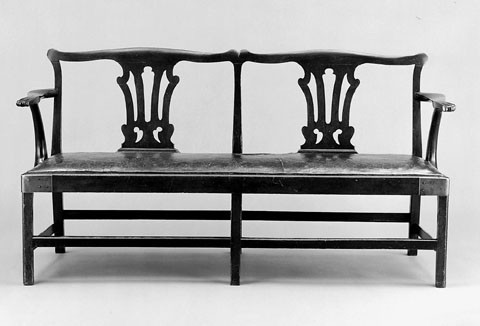
Settee attributed to the shop of Peter Scott, Williamsburg, Virginia, 1771–1776. Cherry with tulip poplar and white oak. H. 36 1/2", W. 73", D. 21 1/2". (Courtesy, Colonial Williamsburg Foundation; photo, Hans Lorenz.)

Smoking chairs, Southampton County, Virginia, ca. 1775. Walnut with yellow pine. H. 32 1/4", W. 2 3/4", D. 25". (Courtesy, Colonial Williamsburg Foundation; photo, Hans Lorenz.)
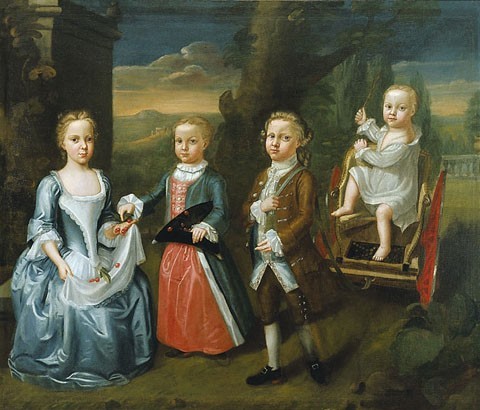
The Grymes Children attributed to John Hesselius, Brandon, Middlesex County, Virginia, ca. 1750. Oil on canvas. 56" x 66 1/4". (Courtesy, Virginia Historical Society.)
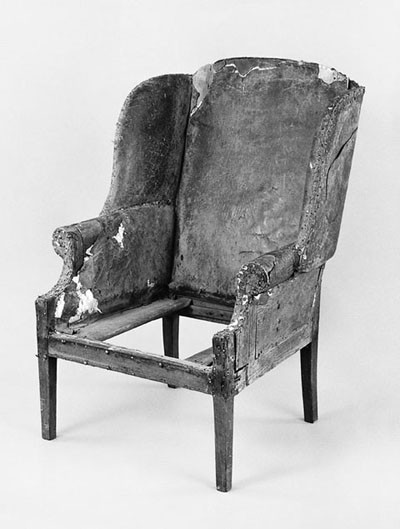
Easy chair, piedmont region of Virginia, ca. 1790. Black walnut with yellow pine; original leather upholstery. H. 44 1/4", W. 28 1/2", D. 22 1/2". (Courtesy, Colonial Williamsburg Foundation; photo, Hans Lorenz.)
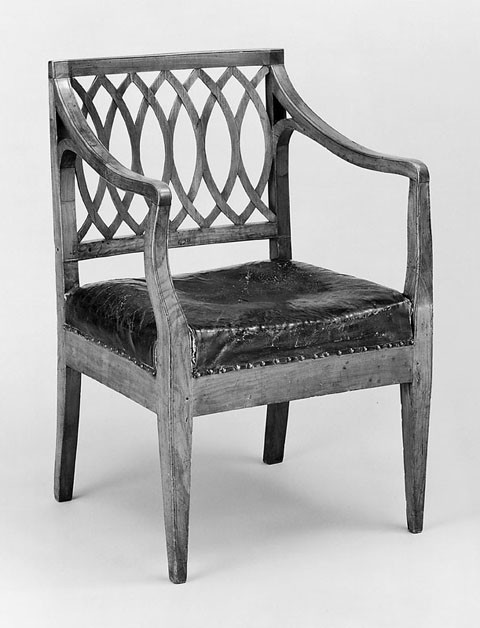
Armchair, probably Albemarle County, Virginia, ca. 1800. Cherry; original black leather upholstery. H. 34 7/8", W. 23 1/4", D. 19 1/4". (Courtesy, Colonial Williamsburg Foundation; photo, Hans Lorenz.)

Detail of the black-grained leather and a stitched seam on the chair illustrated in fig. 18.
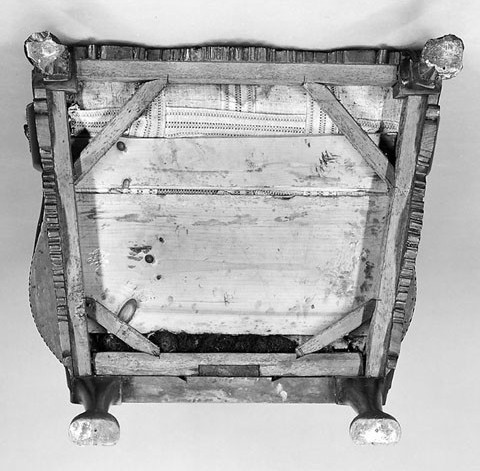
Preconservation view of the bottom of the chair illustrated in fig. 18. (Photo, L. Graves.)
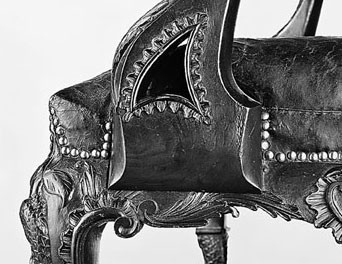
Preconservation detail of the chair illustrated in fig. 18, showing the seat with upholstery peaks visible beneath leather.
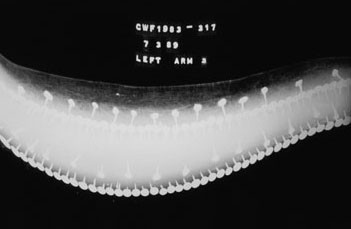
X-radiograph of an armrest on the chair illustrated in fig. 18, showing undisturbed original nails. (Courtesy, Robert Berry, Fabrication Division, Nondestructive Evaluation Section, NASA—Langley Research Center.)

X-radiograph taken above the front seat rail of the chair illustrated in fig. 18, showing one strip of webbing, webbing nails, and the front edge roll. (Courtesy, Robert Berry, Fabrication Division, Nondestructive Evaluation Section, NASA—Langley Research Center.)
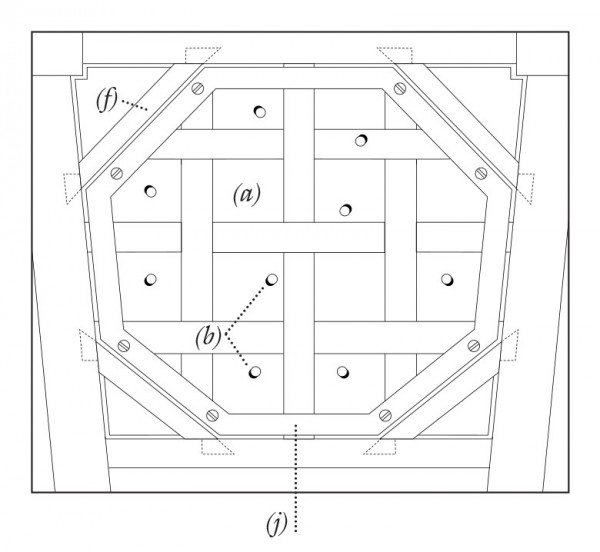
Auxiliary support for the seat of the chair illustrated in fig. 18: (a) 1/4" acrylic support plate beneath the original upholstery, (b) ventilation holes in acrylic support plate, (c) bolt and T-nut, (d) diagonal brace, (e) 4-ply laminated acid-free ragboard. (Drawing, L. Graves; artwork, Wynne Patterson.)

Detail of the corner bracket associated with the auxiliary support for the chair illustrated in fig. 18: (a) 1/4" acrylic support plate beneath the original upholstery, (b) ventilation hole in acrylic support plate, (c) bolt and T-nut, (d) 24-gauge copper Z-shaped bracket, (e) copper rivet, (f) diagonal brace, (g) triangular-shaped 1/8" acrylic support, (h) self-adhesive moleskin, (i) silk Crepeline fabric, (j) 4-ply laminated acid-free ragboard. (Drawing, L. Graves; artwork, Wynne Patterson.)
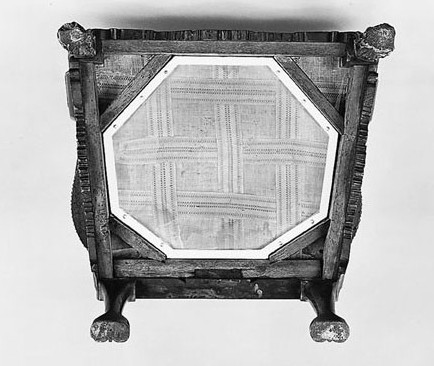
Detail of the underside of the chair illustrated in fig. 18, showing the new auxiliary support. (Photo, L. Graves.)
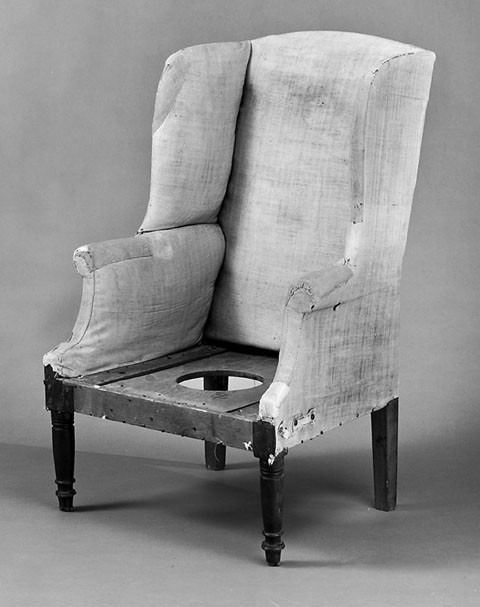
Easy chair, Richmond, Virginia, ca. 1820. Walnut and maple with white pine, yellow pine, and tulip poplar; original upholstery. H. 45 3/4", W. 30 1/4", D. 30 1/2". (Courtesy, Colonial Williamsburg Foundation; photo, Hans Lorenz.)
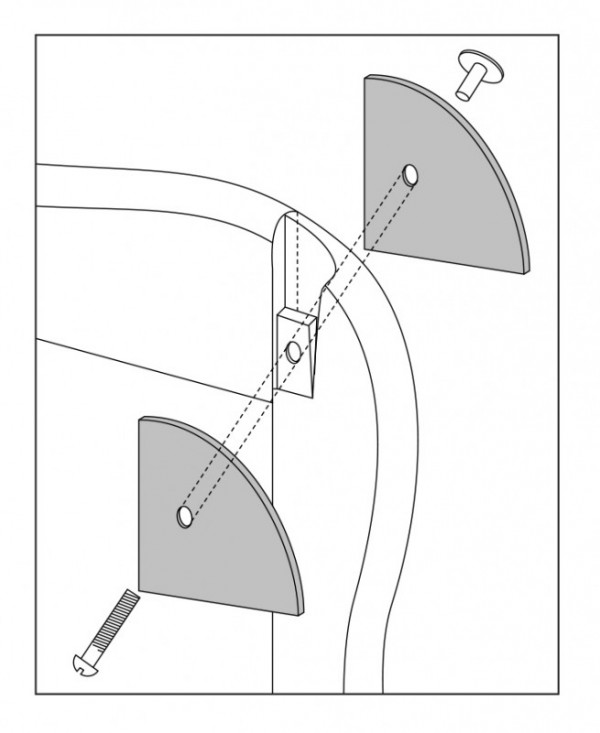
Design for plates used to secure and realign the damaged wing joint of the chair illustrated in fig. 32. (Drawing, L. Graves; artwork, Wynne Patterson.)
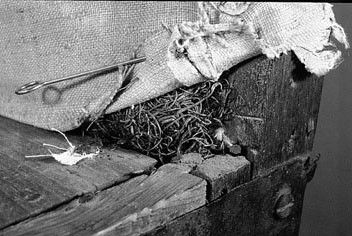
Preconservation detail of exposed Spanish moss stuffing from the chair illustrated in fig. 32. (Photo, L. Graves.)
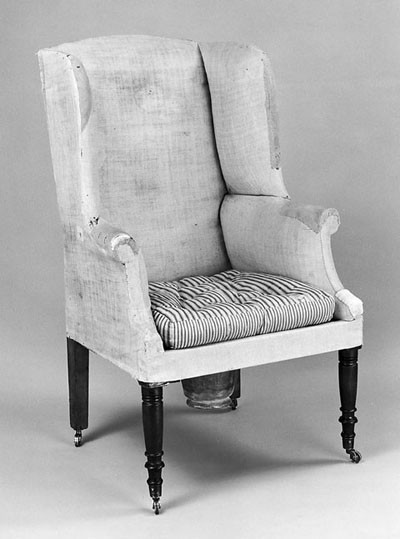
Postconservation view of the easy chair illustrated in fig. 32, showing the stabilized original upholstery.
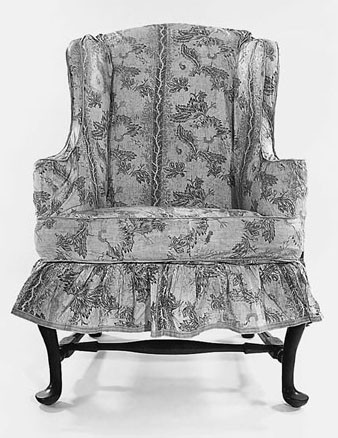
Easy chair, Boston, Massachusetts, 1759. Walnut with white pine and maple; roller-printed chintz slipcover, ca. 1840. Clement Vincent or George Bright, chairmaker. Samuel Grant, upholsterer. H. 46 1/8", W. 33 7/8", D. 21 3/4". (Courtesy, Society for the Preservation of New England Antiquities. A gift of the heirs of Elizabeth Cheever Wheeler. Photograph by David Bohl.)
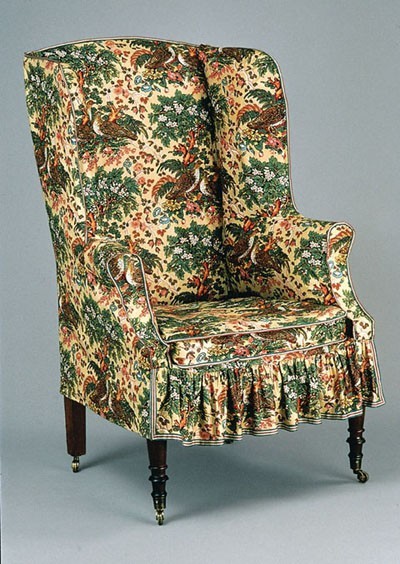
Postconservation view of the easy chair illustrated in fig. 32, showing the new slipcover modeled after the example illustrated in fig. 36. (Photo, Hans Lorenz.)
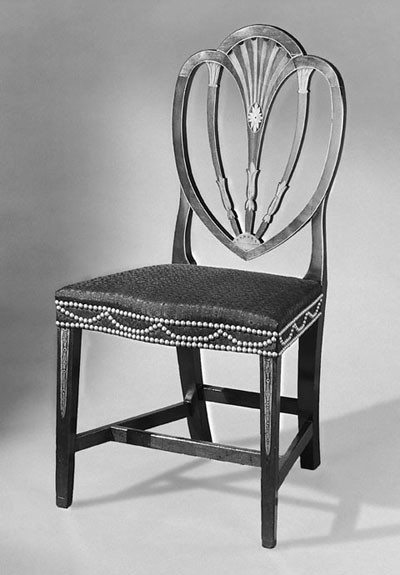
Side chair, probably Norfolk, Virginia, 1790–1810. Walnut and holly inlay with yellow pine. H. 34 1/2", W. 18 3/8", D. 17 1/2". (Courtesy, Colonial Williamsburg Foundation; photo, Hans Lorenz.)

Detail showing evidence of the original brass nail trim on the front seat rail of the chair illustrated in fig. 38. (Photo, L. Graves and F. C. Howlett.)
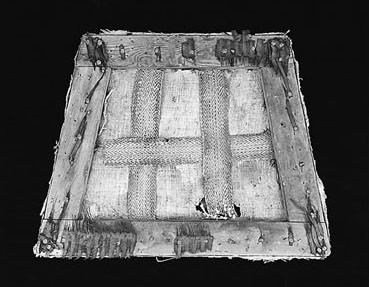
Slipseat frame, Virginia or Britain, ca. 1755. Beech; remnants of original linen and striped, black haircloth. (Courtesy, Colonial Williamsburg Foundation; photo, Hans Lorenz.)

Sofa labeled by Chester Sully, Norfolk, Virginia, 1811. Mahogany with yellow pine, tulip poplar, and ash. H. 37 7/8", W. 72 5/8", D. 23". (Courtesy, Colonial Williamsburg Foundation; photo, Hans Lorenz.)
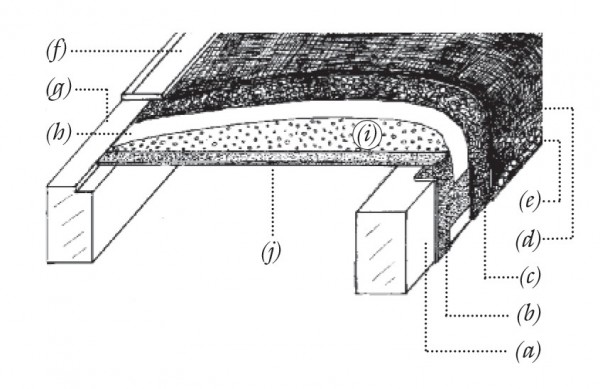
Components of the nonintrusive upholstery system devised for the side chair illustrated in fig. 38: (a) front seat rail, (b) 24-gauge copper face plate, (c) black cotton fabric, (d) haircloth show textile, (e) brass nails, (f) removable shoe molding, (g) rear seat rail, (h) polyester batting, (i) Ethafoam, (j) 32-gauge copper foundation. (Drawing, L. Graves; artwork, Wynne Patterson.)

Postconservation view of the side chair illustrated in fig. 38.

Sofa, Winchester, Virginia, 1790–1800. Black walnut and maple inlay with yellow pine and tulip poplar. H. 37", W. 89", D. 27 1/2". (Courtesy, Colonial Williamsburg Foundation; photo, Hans Lorenz.)

Sofa, Winchester, Virginia, 1790–1800. Black walnut and maple inlay with yellow pine and tulip poplar. H. 37", W. 86 1/2", D. 27 1/4". (Private collection; photo, Hans Lorenz.)

Detail of an inlaid leg on the sofa illustrated in fig. 44.
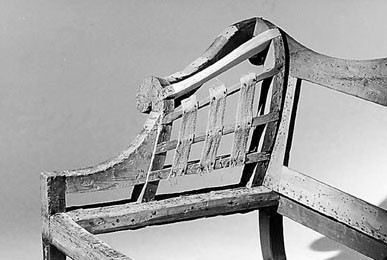
Detail of the arm assembly and seat rails of the sofa illustrated in fig. 44.
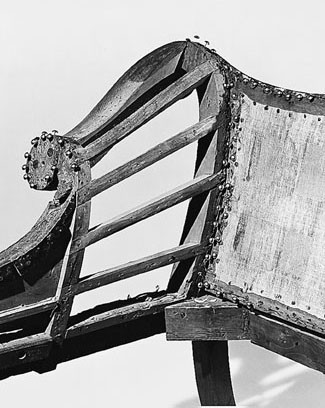
Detail of the sofa illustrated in fig. 45, with modern nails pointing out original brass nail locations.
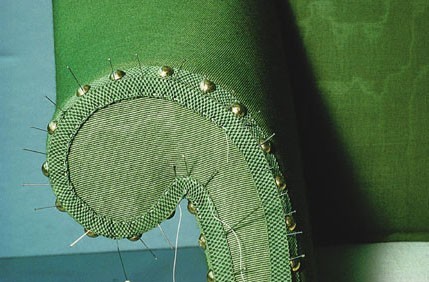
Detail of the sofa illustrated in fig. 44, with new upholstery and trim applied according to evidence found on the frame. (Photo, L. Graves and F. C. Howlett.)
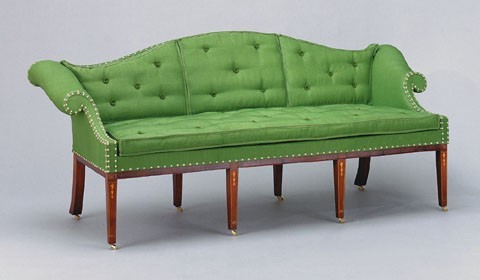
Postconservation view of the sofa illustrated in fig. 44, with cushions fabricated according to a dimensional study of the frame. (Photo, Hans Lorenz.)
